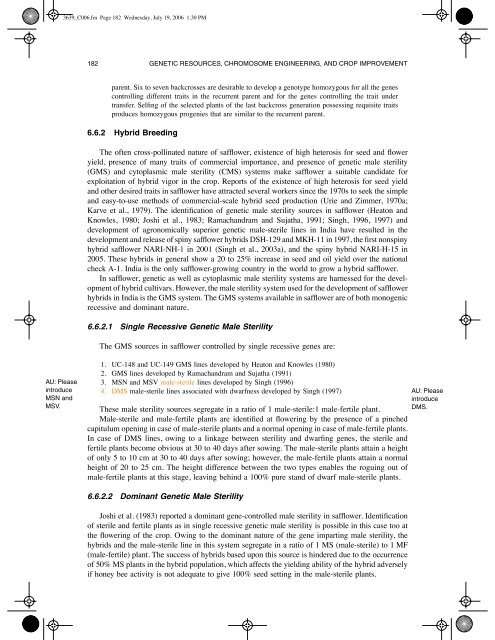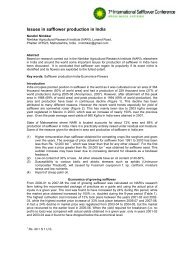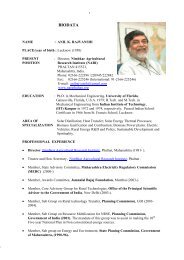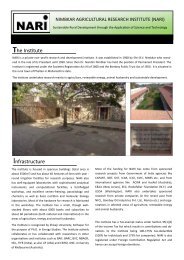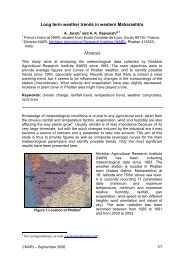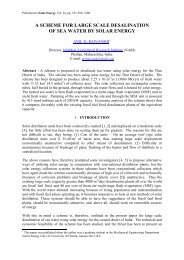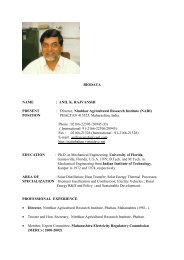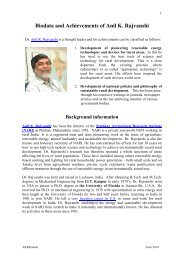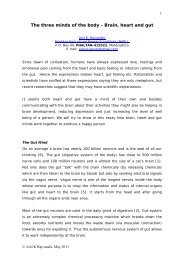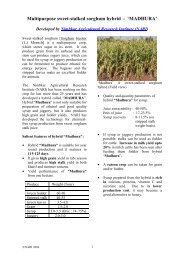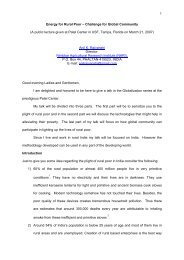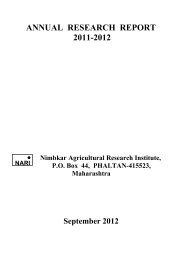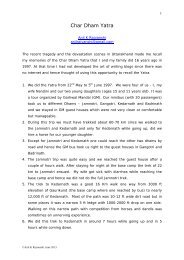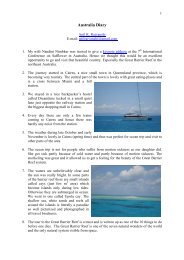3639_C006.fm Page 182 Wednesday, July 19, 2006 1:30 PM182 GENETIC RESOURCES, CHROMOSOME ENGINEERING, AND CROP IMPROVEMENTparent. Six to seven backcrosses are desirable to develop a genotype homozygous for all the genescontrolling different traits in the recurrent parent and for the genes controlling the trait undertransfer. Selfing of the selected plants of the last backcross generation possessing requisite traitsproduces homozygous progenies that are similar to the recurrent parent.6.6.2 Hybrid BreedingThe often cross-pollinated nature of safflower, existence of high heterosis for seed and floweryield, presence of many traits of commercial importance, and presence of genetic male sterility(GMS) and cytoplasmic male sterility (CMS) systems make safflower a suitable candidate forexploitation of hybrid vigor in the crop. Reports of the existence of high heterosis for seed yieldand other desired traits in safflower have attracted several workers since the 1970s to seek the simpleand easy-to-use methods of commercial-scale hybrid seed production (Urie and Zimmer, 1970a;Karve et al., 1979). The identification of genetic male sterility sources in safflower (Heaton andKnowles, 1980; Joshi et al., 1983; Ramachandram and Sujatha, 1991; Singh, 1996, 1997) anddevelopment of agronomically superior genetic male-sterile lines in India have resulted in thedevelopment and release of spiny safflower hybrids DSH-129 and MKH-11 in 1997, the first nonspinyhybrid safflower <strong>NARI</strong>-NH-1 in 2001 (Singh et al., 2003a), and the spiny hybrid <strong>NARI</strong>-H-15 in2005. These hybrids in general show a 20 to 25% increase in seed and oil yield over the nationalcheck A-1. India is the only safflower-growing country in the world to grow a hybrid safflower.In safflower, genetic as well as cytoplasmic male sterility systems are harnessed for the developmentof hybrid cultivars. However, the male sterility system used for the development of safflowerhybrids in India is the GMS system. The GMS systems available in safflower are of both monogenicrecessive and dominant nature.6.6.2.1 Single Recessive Genetic Male SterilityThe GMS sources in safflower controlled by single recessive genes are:AU: PleaseintroduceMSN andMSV.1. UC-148 and UC-149 GMS lines developed by Heaton and Knowles (1980)2. GMS lines developed by Ramachandram and Sujatha (1991)3. MSN and MSV male-sterile lines developed by Singh (1996)4. DMS male-sterile lines associated with dwarfness developed by Singh (1997)These male sterility sources segregate in a ratio of 1 male-sterile:1 male-fertile plant.Male-sterile and male-fertile plants are identified at flowering by the presence of a pinchedcapitulum opening in case of male-sterile plants and a normal opening in case of male-fertile plants.In case of DMS lines, owing to a linkage between sterility and dwarfing genes, the sterile andfertile plants become obvious at 30 to 40 days after sowing. The male-sterile plants attain a heightof only 5 to 10 cm at 30 to 40 days after sowing; however, the male-fertile plants attain a normalheight of 20 to 25 cm. The height difference between the two types enables the roguing out ofmale-fertile plants at this stage, leaving behind a 100% pure stand of dwarf male-sterile plants.AU: PleaseintroduceDMS.6.6.2.2 Dominant Genetic Male SterilityJoshi et al. (1983) reported a dominant gene-controlled male sterility in safflower. Identificationof sterile and fertile plants as in single recessive genetic male sterility is possible in this case too atthe flowering of the crop. Owing to the dominant nature of the gene imparting male sterility, thehybrids and the male-sterile line in this system segregate in a ratio of 1 MS (male-sterile) to 1 MF(male-fertile) plant. The success of hybrids based upon this source is hindered due to the occurrenceof 50% MS plants in the hybrid population, which affects the yielding ability of the hybrid adverselyif honey bee activity is not adequate to give 100% seed setting in the male-sterile plants.
3639_C006.fm Page 183 Wednesday, July 19, 2006 1:30 PMSAFFLOWER (CARTHAMUS TINCTORIUS L.) 1836.6.2.3 Cytoplasmic-Genetic Male SterilityCytoplasmic-genetic male sterility (CGMS) has been reported to be exploited for hybrid developmentin safflower (Hill, 1989). The evaluation of CMS hybrids carried out in comparison withthe GMS-based hybrids in India revealed the seed yield of CMS hybrids to be only 50% that ofthe corresponding GMS hybrids. In addition, all the CMS-based hybrids segregated into sterile andfertile plants, thereby suggesting the lack of fertility restoration to the sterile cytoplasm (Singhet al., 2000). The commercialization of CMS-based hybrids is still awaited.In India, too, efforts are under way to develop a CGMS system in safflower at the NimbkarAgricultural Research Institute (<strong>NARI</strong>), Phaltan (Singh et al., 2001a), and at the Directorate ofOilseeds Research, Hyderabad. The CGMS systems at <strong>NARI</strong> are being developed by followinginterspecific crossing and mutagenesis with streptomycin. Both programs have resulted in developmentof CMS in safflower. Genotypes causing 100% restoration of fertility to the sterile cytoplasmhave been identified in both cases (Singh, 2005b). Efforts are being made to develop suitablemaintainer genotypes that can maintain 100% male sterility in the sterile cytoplasm.6.6.3 Breeding for End UseIn general, safflower around the world is grown under rain-fed conditions. Therefore, theincidence of disease and pest infestation is reported to be of low severity. However, under favorableconditions they may cause considerable damage to the crop, as had happened in India during 1997to 1998, when the entire crop of safflower in the major safflower-growing states of Maharashtraand Karnataka was completely wiped out by an outbreak of Alternaria (Anonymous, 1997–1998).In view of the above, the major emphasis in safflower improvement has been laid on seed yield;however, to meet the requirements of local agroclimatic conditions, cropping patterns, and marketrequirements, safflower improvement has also been directed to breed cultivars resistant to diseasesand pests, and improved oil content and quality.6.6.3.1 Disease Resistance<strong>Safflower</strong> is attacked by many diseases caused by fungi, bacteria, viruses, or physiologicaldisorders due to abiotic stresses. Patil et al. (1993) reported that safflower is recorded to be infestedaround the world by 57 pathogens, including 40 fungi, 2 bacteria, 14 viruses, and 1 mycoplasma.Of these, Alternaria leaf spot caused by Alternaria carthami and wilt caused by Fusariumoxysporum are the most devastating ones and can cause 13 to 49% losses and wipe out the entirecrop in the region under conditions conducive to their development, as indicated above in the caseof India.Breeding safflower for disease resistance is the most economical and convenient method forcontrolling major diseases in safflower. Mundel and Huang (2003) described in detail how to controlmajor diseases of safflower by breeding and using cultural practices. The genetics and the modeof inheritance of disease resistance and tolerance in safflower have not been studied for mostdiseases (Li and Mundel, 1996). Though germplasm lines or cultivars showing partial or fullresistance to some of the major diseases have been identified, the genetics has been determinedonly for a few. Karve et al. (1981) showed that resistance to each of the diseases, viz., Alternariacarthami Chowdhari, Cercospora carthami Sund and Ramak, Ramularia carthami Zaprom,Fusarium oxysporum Sehl. ex. Fries, Rhizoctonia bataticola Bult, and Rhizoctonia Solani Kuhn,is imparted by single dominant genes. Study of inheritance of wilt (Fusarium oxysporum) resistancein safflower revealed the control of inhibitory gene action in the expression of wilt resistance insafflower (Singh et al., 2001b). The source of resistance to wilt has been identified in the localgermplasm lines (Sastry and Ramachandram, 1992). Breeding for wilt resistance in safflowerfollowing backcross resulted in the development of wilt-resistant genotypes giving an increase in
- Page 1: 3639_C006.fm Page 167 Wednesday, Ju
- Page 4 and 5: 3639_C006.fm Page 170 Wednesday, Ju
- Page 6 and 7: 3639_C006.fm Page 172 Wednesday, Ju
- Page 8: 3639_C006.fm Page 174 Wednesday, Ju
- Page 11 and 12: 3639_C006.fm Page 177 Wednesday, Ju
- Page 13 and 14: 3639_C006.fm Page 179 Wednesday, Ju
- Page 15: 3639_C006.fm Page 181 Wednesday, Ju
- Page 19 and 20: 3639_C006.fm Page 185 Wednesday, Ju
- Page 21 and 22: 3639_C006.fm Page 187 Wednesday, Ju
- Page 23 and 24: 3639_C006.fm Page 189 Wednesday, Ju
- Page 25 and 26: 3639_C006.fm Page 191 Wednesday, Ju
- Page 27 and 28: 3639_C006.fm Page 193 Wednesday, Ju


